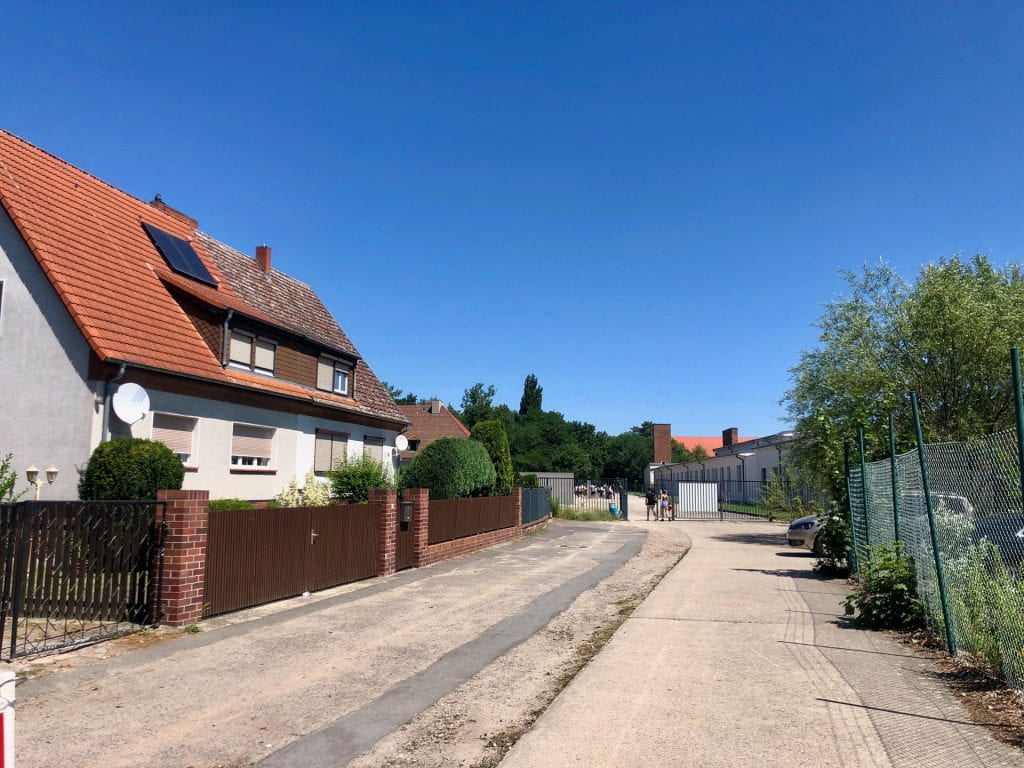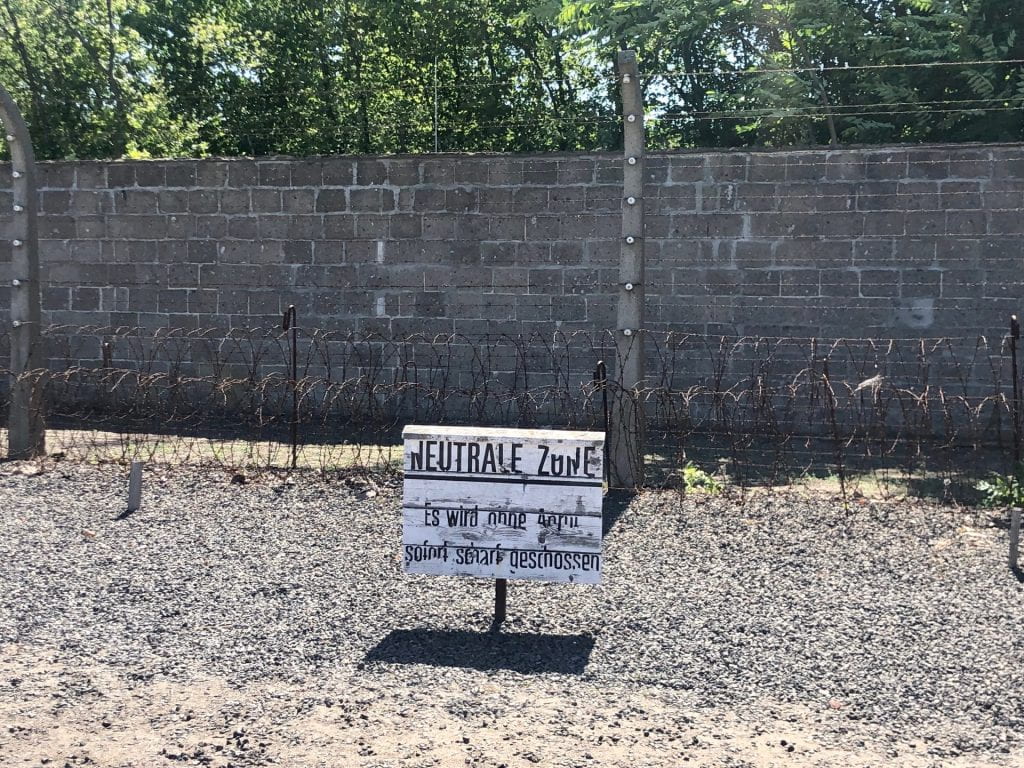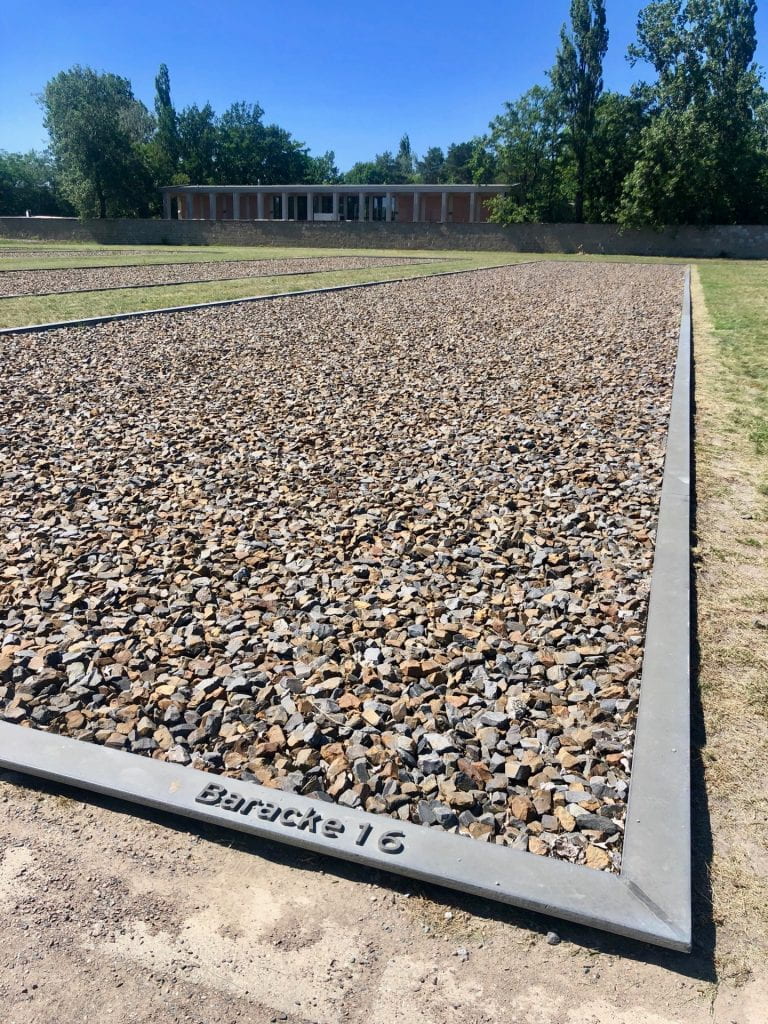Today marked the beginning of the end of our time in Germany in many ways. While it was our second to last day in Germany, it also brought our trip full circle. We spent our first days in Germany learning about Thomas Buergenthal’s life in Göttingen after WWII and today we traveled to Sachsenhausen, the infamous concentration camp where Thomas spent his last days of WWII in and eventually was liberated from. Visiting the camp was a sobering experience, to stand in the same area that so many were brutally victimized stays with you for a long time. The Sachsenhausen camp is only about an hour outside of Berlin and we were able to take a train directly from Berlin to the town of Oranienburg, where the Sachsenhausen Memorial Museum is currently located. I was immediately startled outside the camp as to the proximity of the camp to the town of Oranienburg. The Sachsenhausen concentration camp was built in the summer of 1936 as a model and training camp and the camp is mere yards from several houses on the out skirts of town. I later learned during our tour that these houses were built by the slave laborers of the camp and often SS guards and their families lived within these homes. This image immediately took me back to the story, “The Boy in the Striped Pajamas”, as I imagined children of guards looking out their bedroom windows witnessing the daily atrocities that took place in this camp.

(House in the village in the background is the fence for the camp.)
Upon walking into the museum, we were greeted by our guide who provided us with extensive background on the camp prior to our guided tour. During this lecture, my TOP 3 group and I learned that this camp was the first new concentration camp to be established under the orders of SS leader Heinrich Himmler. It was designed as a model camp and was used for training SS guards. More than 200,000 people were imprisoned in Sachsenhausen between 1936 and 1945. Those targeted included Jews, gypsies, career criminals, people persecuted as being homosexual, as well as various prisoners of war. Nearby factories provided the initial forced labor for members of the camp with the worlds largest brickworks near Oranienburg. As a forced laborer if you were assigned to work at the brick factory your life expectancy was a startling two to nine months. After nearly a decade of operation, in 1945, as the Red Army approached there was a mass evacuation of the camp in a Nazi attempt to cover up the crimes they had committed. Nearly 30,000 of the remaining prisoners were sent on a death march of which thousands died. On April 22, 1945 the camp was liberation by Soviet and Polish Armies. Therefore, those who remained at the camp unable to join the death march, approximately 3,000 sick, as well as nurses and doctors were finally free.

There were so many areas that we saw during our tour of the camp that really caused me to stop and take a moment to reflect, here are just a handful of those moments.
Upon entering the camp from the outside gates (as prisoners would have done when first marched in) you see Tower A. This was the command base for the camp and was the location where SS officers and staff had direct power over their prisoners. The gate as you walk through the bottom of Tower A has the infamous phrase “Arbeit Macht Frei” or “Work sets you free”.

Now in Tower A serves as a permanent exhibit called “The Camp-SS 1936-1945: Excesses and Direct Perpetrators”. Within the exhibit, museum visitors are able to learn about the special design of Sachsenhausen concentration camp, as well of the goal of the SS guards to continuously administer fear into their victims. I personally felt the immediate feeling of fear as I stared out the large windows where the machine gun once faced. From these windows you have a view of the entire camp. My mind immediately was drawn back to Thomas Buergenthal’s memoir “A Lucky Child”, where he describes his personal fear of walking out in the open in front of this weapon, never knowing when it might be used on its next victim. The idea that you were never safe is unfathomable. From this tower, I could also see the roll call area where prisoners stood for hours in the blistering heat or bitter cold at the mercy of prison guards.

After leaving Tower A our group then walked past remnants of the horrific electric fence and border wall – still intact to demonstrate how the Nazi guards instilled fear every day in their victims.

Many of the initial barracks of the camp are no longer standing, however, you can find the outlines of each former barrack through metal plaques on the grounds.

Two barracks that are still standing are barrack 38 and 39. These two buildings held Jewish prisoners of war from 1938-1942 and now are used to tell the story of Jewish prisoners of war in the camp. It is startling to imagine up to 400 people crammed into this barrack, which was originally only intended to hold 150. With Himmler’s orders to deport all Jewish prisoners to Auschwitz in 1942 many of those originally housed here were transported to Auschwitz. Barrack 39 houses an exhibit called “The Everyday Life of Prisoners in Sachsenhausen Concentration Camp 1936-1945”. Using testimonies of twenty former prisoners, visitors can learn about the daily life that occurred when living in such treacherous conditions.

The infirmary of Sachsenhausen (medical ward) was one where a colleague and I spent significant time in due to the direct connection to Thomas Buergenthal. After he survived the death march of Auschwitz Thomas experienced significant frostbite on his toes. Once he arrived in Sachsenhausen, unable to bear the pain any longer he was taken to the infirmary by his friends. Knowing that many individuals in Auschwitz who went into this medical ward, never came out, he was truly desperate to get medical help. It was here in this medical ward that he came under the care of Dr. … who not only provided him with the medical care that he needed, but also helped him to survive by providing him with various items he had received from his Danish Red Cross care package. In fact, Thomas was in this infirmary when he heard the Soviet and Polish troops outside the camp liberating it on April 22nd, 1945. The infirmary now houses a permanent exhibit which contains various information about the medical care and crimes that occurred within this camp.

Another building of importance is the prisoners kitchen, which now houses an exhibit that examines the events and developments that occurred throughout the camp. There were a variety of primary sources housed within this building including prisoner armbands, photographs and objects commonly found within the camp.

One of the most terrifying places within the camp was the execution trench and burial ground. Going against the Geneva Code, SS guards murdered thousands of Soviet prisoners of war here in just a matter of one week. The feeling in the air as visitors quietly walked past the destroyed crematorium I cannot put in words. This was an area that as an adult was hard to walk through and will stay with me for a long time.

To end my time at Sachsenhausen, I walked through the special exhibit “In The Country of Numbers Where the Men Have No Names”. The title alone of this exhibit was so poignant – I’ve never considered this, but it makes so much sense. The Nazi regime was obsessed with numbers, yet, many of the people under this regime were viewed as nothing but a number. Not even worthy enough to be identified by their name. This exhibit includes interviews with survivors’ families, as well as various primary sources, including, documents, pictures and digital material. This exhibit along with all that I witnessed within the Sachsenhausen concentration camp will forever stay with me and impact how I teach my students about the atrocities of the Holocaust.
Sachsenhausen Concentration Camp Website: https://www.sachsenhausen-sbg.de
Holocaust Memorial Excerpt on Thomas Buergenthal: https://www.ushmm.org/confront-genocide/speakers-and-events/biography/thomas-buergenthal